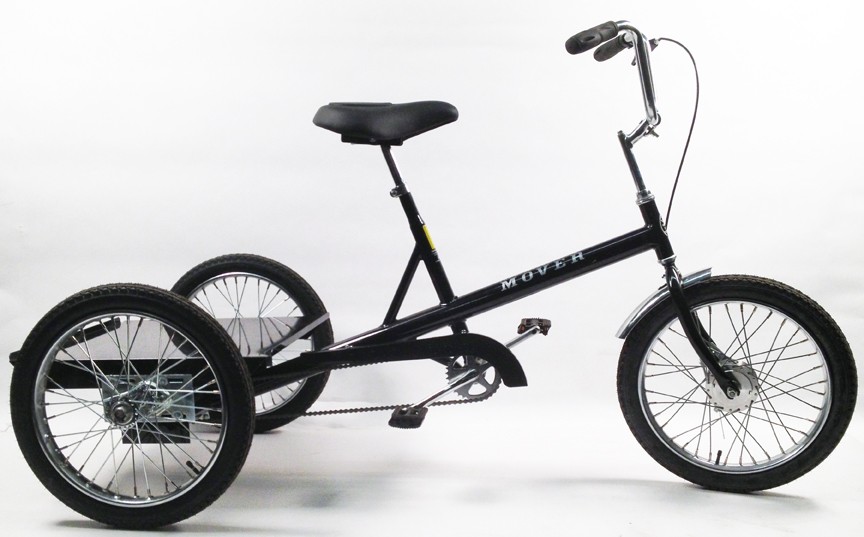Rethinking Urban Infrastructure for Cargo Bikes: How Worksman Cycles Builds for Today's Streets
 In many cities, the sight of a cargo bike navigating traffic, loaded with groceries, tools, or even children, is becoming more and more common. These heavy-duty bikes provide a sustainable, affordable, and efficient alternative to cars, particularly in densely populated urban areas where parking and congestion make car ownership increasingly impractical.
In many cities, the sight of a cargo bike navigating traffic, loaded with groceries, tools, or even children, is becoming more and more common. These heavy-duty bikes provide a sustainable, affordable, and efficient alternative to cars, particularly in densely populated urban areas where parking and congestion make car ownership increasingly impractical.
But there's a problem: the infrastructure hasn't caught up.
While cities claim to support bike-friendly policies, many streets still don't accommodate the size, turning radius, or load demands of cargo bikes. That leaves riders to fend for themselves on narrow lanes, dodge cars at intersections, and wrestle their way through inaccessible curbs or confusing loading zones.
Still, thousands of people are turning to cargo bikes anyway—and companies like Worksman Cycles are meeting that demand with innovative, robust designs that respond directly to those challenges.
Why Cargo Bikes Are a Smart Move for Urban Riders
Cargo bikes solve a problem that regular bikes don't: load capacity. Whether you're a parent trying to get two kids to school or a small business owner hauling supplies, a cargo bike provides many advantages.
- Ample storage (often 100+ lbs or more)
- Stable handling, even when fully loaded
- No need for parking permits
- Zero fuel costs
- Clean transportation with real carbon impact
Cargo bikes are particularly well-suited for short-distance, high-frequency tasks—such as delivering meals, picking up hardware, or running errands—where a car feels like overkill but walking isn't efficient. For gig workers, restaurants, tradespeople, and even municipal services, they're not just a bike. They're a business vehicle.
For cities aiming to meet climate goals, reduce traffic, and expand access, cargo bikes are a potential game-changer.
The Infrastructure Lag: What Cities Are Missing
Unfortunately, many urban areas are still designed around cars—not the needs of 8-foot-long bicycles with wide turns and heavy payloads. Let's break down some of the key infrastructure challenges.
- Narrow or Inconsistent Bike Lanes: Most bike lanes are designed for single-rider bicycles—not three-wheeled industrial trikes or front-loading longtails. If you're carrying 200 pounds of cargo, squeezing between traffic and the curb is not only impractical, it's dangerous. Cargo bikes require wider lanes, improved lane continuity, and buffer zones to protect them from fast-moving cars.
- Lack of Loading Zones: For delivery riders or tradespeople, simply finding a safe space to load and unload a cargo bike is a challenge. Curbs are too high. Ramps are missing. "No parking" zones often aren't bike-accessible. Urban planning should consider micro-loading zones and bike-accessible curbs that work for trikes and e-cargo setups.
- Traffic Signal Timing: Cargo bikes move slower than road bikes, especially when loaded. Yet traffic lights rarely provide enough time to cross multi-lane intersections without hurrying. Cities could implement cargo bike timing adjustments or signal priority in high-use areas.
- Insufficient Parking or Lock-Up Options: A cargo bike isn't just a commuter bike you can lock to a street sign. These vehicles need secure, dedicated parking spaces—preferably under shelter and near building entrances. Infrastructure must support the fact that cargo bikes often replace cars. They need real parking solutions.
- Street Design That Favors Cars: From narrow shoulders to blind corners and confusing signage, many streets are simply hostile to anything not on four wheels. And when roads are repaved or redesigned, cargo bikes are rarely considered. Street policies must explicitly include cargo bikes in planning.
How Worksman Cycles Designs Around These Obstacles
Despite the infrastructure gap, thousands of people use cargo bikes every day—and Worksman Cycles has made it their mission to make that possible. Worksman is one of America's oldest bicycle manufacturers and a pioneer in industrial cargo bike design. Here's how our models help riders overcome urban infrastructure limitations:
- Stable, Upright Frames Built for Traffic: Worksman cargo tricycles (like the Adaptable Industrial Trike) are designed for stability in stop-and-go traffic. Wide rear axles, low step-through frames, and upright riding positions improve visibility in crowded street conditions. This helps riders maintain control—even with heavy loads—and interact more safely with cars and pedestrians.
- Compact Designs for Tight Streets: While some cargo bikes have extended frames that make urban maneuvering a headache, Worksman offers shorter wheelbase options that still deliver high cargo capacity. This is especially valuable in older cities like New York, Boston, or Philadelphia, where alleyways and loading docks weren't built for oversized vehicles. Many of our models are compact enough to fit on sidewalks, through doorways, and around narrow city corners—without sacrificing durability.
- Heavy-Duty Racks and Baskets Designed for Quick Loading: Workman's front and rear cargo platforms are purpose-built for utility, offering a wide, flat, and stable design with custom bracket options. Riders don't need to fumble with aftermarket accessories or precarious tie-downs. That's a significant advantage when loading occurs at street level without formal docking stations. The Worksman Executive Trike, for example, is popular with maintenance teams because it allows tools, ladders, and even vacuum units to be mounted securely and accessed quickly.
- Electric Assist Options to Keep Riders Moving: Carrying 200 pounds up a hill or through a windy avenue? Worksman's electric-assist options, available on many models, help bridge the gap between human power and infrastructure limits. You don't need bike-only greenways or downhill routes—just the right setup and a reliable battery. That means more viable trips, even in cities with bad elevation or long blocks between bike-friendly zones.
- Custom Paint, Branding, and Setup: Since Worksman serves both individuals and companies, their bikes can be tailored to suit business needs—an essential factor in cities where cargo bikes double as mobile storefronts or branded delivery tools. Whether you're a coffee vendor or a city employee, the bike isn't just about function—it's also about public presence. That matters when urban policies and community support are still catching up.
What a Cargo-Bike-Friendly City Actually Looks Like
So what would it take to make cities truly cargo bike–friendly?
- Designated wide lanes that accommodate two-wheeled and three-wheeled cargo bikes
- Priority curb access zones for commercial and personal loading
- Protected intersections that slow turning cars and give visibility to larger bikes
- Secure cargo bike parking at schools, grocery stores, and commercial hubs
- Zoning incentives for businesses that switch delivery fleets from vans to cargo bikes
- Government subsidies or rebates for purchasing American-made cargo bikes (especially for small businesses)
Cities like Amsterdam and Copenhagen have long incorporated cargo bikes into their daily life, not as novelty items but as a vital part of their transportation infrastructure. In the U.S., cities like Portland and NYC are beginning to catch on—but progress is slow.
Until then, companies like Worksman Cycles continue to design with real-world conditions in mind—bridging the gap between what infrastructure should be and what it currently is.
Build for the Bike You Want to See
The rise of cargo bikes isn't a fad—it's a response to urban problems that cars can no longer solve. Congestion, emissions, delivery inefficiencies, last-mile access, and public health all improve when cities make room for human-powered transport.
But bikes don't exist in a vacuum. They thrive—or struggle—based on how streets are built around them. If cities want to take climate goals seriously, address last-mile logistics, and create livable neighborhoods, they need to think beyond painted bike lanes and start building for the bikes that carry real weight.
In the meantime, Worksman Cycles is proving that American-made cargo bikes can do more than endure these challenges—they can thrive despite them.







